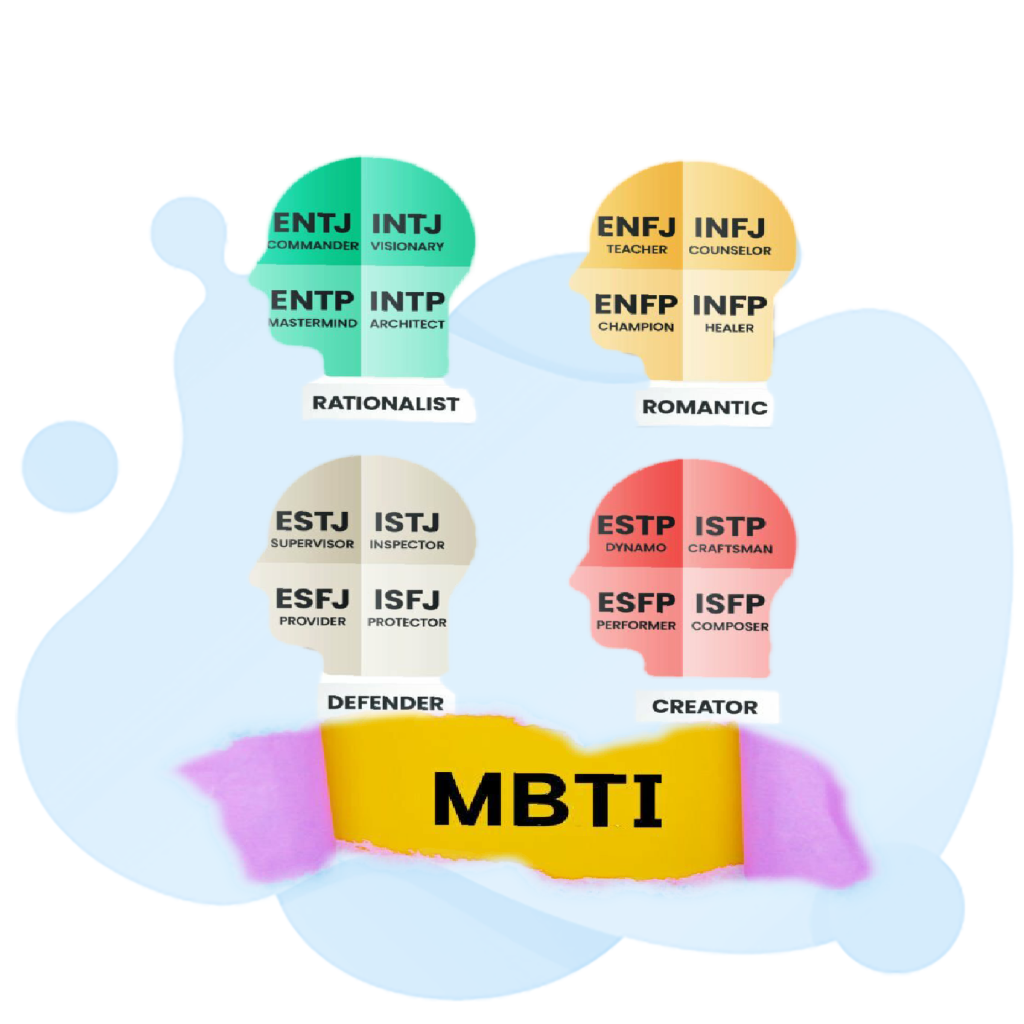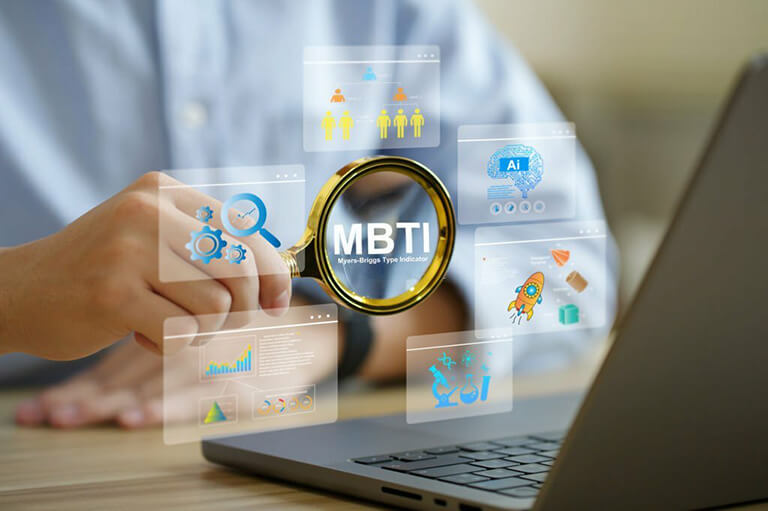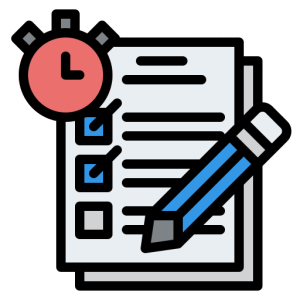MBTI Test 2023

The MBTI test enables individuals to gain a deeper understanding of their natural inclinations and tendencies across various aspects of their lives. The first dichotomy, Extraversion or Introversion, reflects the source of an individual’s energy—whether they are more energized by external interactions (Extraversion) or by internal reflection and solitude (Introversion). Sensing or Intuition pertains to the way individuals gather information, through concrete details (Sensing) or abstract patterns and possibilities (Intuition). Thinking or Feeling reflects the decision-making process—whether individuals rely on logical analysis (Thinking) or on personal values and emotions (Feeling). The final dichotomy, Judging or Perceiving, represents an individual’s approach to structure and planning (Judging) versus flexibility and spontaneity (Perceiving).
Free MBTI Practice Test Online
MBTI Personality Test
The Myers-Briggs Type Indicator (MBTI) personality test is a widely recognized assessment designed to reveal an individual’s psychological preferences. Developed by Katharine Cook Briggs and her daughter Isabel Briggs Myers, this test is rooted in Carl Jung’s theories of personality. The MBTI test categorizes individuals into one of 16 distinct personality types, based on four dichotomies: Extraversion (E) or Introversion (I), Sensing (S) or Intuition (N), Thinking (T) or Feeling (F), and Judging (J) or Perceiving (P). These preferences shape an individual’s approach to the world, influencing communication, decision-making, and interpersonal interactions.
Understanding the categories within the MBTI test unveils the intricacies of an individual’s personality. The first dichotomy, Extraversion or Introversion, defines whether individuals are energized by external interactions or by introspection and solitude. Sensing or Intuition describes how individuals gather information—through concrete details or abstract patterns and possibilities. The Thinking or Feeling dichotomy illuminates the decision-making process, whether individuals rely on logical analysis or personal values and emotions. The final dichotomy, Judging or Perceiving, reflects an individual’s approach to structure and planning versus flexibility and spontaneity.
The insights gained from the MBTI personality test extend beyond self-understanding, impacting both personal and professional aspects of life. Individuals often use their MBTI type to make informed decisions about career paths, communication styles, and conflict resolution strategies. Additionally, organizations and teams utilize the MBTI to enhance teamwork and productivity by understanding and leveraging diverse personalities. The MBTI test is not about limiting individuals to specific categories but serves as a tool for self-awareness, fostering empathy, and appreciating the diversity of personalities, contributing to personal growth and improved relationships.
The Myers-Briggs Type Indicator (MBTI) personality test serves as a powerful tool in unraveling an individual’s psychological preferences, providing a framework for understanding how personality influences various aspects of life.
MBTI Compatibility Chart
The MBTI Compatibility Chart is an exploratory tool used to assess the potential compatibility between individuals based on their Myers-Briggs Type Indicator (MBTI) personality types. Rooted in the 16 personality types categorized by the MBTI, this chart aims to offer insights into how different personality types may interact and relate to one another. The chart outlines potential compatibility or synergy between specific personality types, shedding light on how these types might complement or challenge each other in various aspects of a relationship, whether personal or professional.
The MBTI Compatibility Chart considers the interaction between different pairs of personality types across the four dichotomies—Extraversion/Introversion, Sensing/Intuition, Thinking/Feeling, and Judging/Perceiving. It explores the potential dynamics between, for instance, an Extraverted type and an Introverted type, or between a Thinking type and a Feeling type. The chart typically presents the compatibility between each type, suggesting areas of potential harmony, sources of conflict, and potential areas for growth within the relationship. It serves as a guide, offering an understanding of how differing personality preferences might influence communication styles, conflict resolution, and overall relationship dynamics.
While the MBTI Compatibility Chart can offer valuable insights into potential compatibility or areas of tension within relationships, it’s essential to view it as a tool for understanding rather than a rigid determinant of relationship success. The chart provides a starting point for reflection and communication within relationships. Understanding how differing personality types might interact allows individuals to appreciate the diversity in relationships and encourages open discussions about preferences, needs, and areas for compromise. By leveraging this tool, individuals can harness insights to navigate and enhance their relationships based on a deeper understanding of each other’s MBTI types.
The MBTI Compatibility Chart serves as a guide for understanding the potential dynamics between various personality types, offering insights into how different types might interact within relationships.

MBTI Categories
The Myers-Briggs Type Indicator (MBTI) delves into an individual’s personality through four dichotomies, resulting in 16 distinct personality types. These dichotomies—Extraversion (E) or Introversion (I), Sensing (S) or Intuition (N), Thinking (T) or Feeling (F), and Judging (J) or Perceiving (P)—form the basis of the MBTI categories. Extraversion and Introversion reflect how individuals recharge their energy, whether through external interactions or internal reflection, respectively. Sensing or Intuition focuses on how individuals gather information—through tangible details or abstract patterns. Thinking or Feeling signifies the decision-making process, whether relying on logic or personal values. Lastly, Judging or Perceiving captures an individual’s approach to structure and flexibility.
The first dichotomy, Extraversion or Introversion, signifies the orientation of an individual’s energy. Extraverts draw energy from external activities and interactions, while Introverts gain energy from introspection and solitary activities. Sensing or Intuition describes an individual’s information-gathering process—Sensing types concentrate on tangible details, facts, and experiences, while Intuitive types focus on abstract connections, possibilities, and meanings. Thinking or Feeling represents the decision-making process—Thinkers prioritize logical analysis and objectivity, while Feelers emphasize personal values and empathetic consideration.
The Judging or Perceiving dichotomy reflects an individual’s approach to organizing their outer world. Judgers prefer structure, planning, and decisiveness, while Perceivers favor flexibility, adaptability, and openness. Each of these dichotomies produces a combination of preferences resulting in the 16 distinct personality types, such as ISTJ (Introverted, Sensing, Thinking, Judging) or ENFP (Extraverted, Intuitive, Feeling, Perceiving). These personality types form the foundation for understanding individual tendencies, preferences, and approaches across various aspects of life, from decision-making to communication and relationships.
The MBTI categories, formed by the four dichotomies of Extraversion/Introversion, Sensing/Intuition, Thinking/Feeling, and Judging/Perceiving, offer insights into an individual’s psychological preferences, shaping their perspective and approach to the world.
MBTI Test Results
The Myers-Briggs Type Indicator (MBTI) test results offer a comprehensive view of an individual’s personality, providing insights into how they perceive and interact with the world. The test, based on four dichotomies—Extraversion (E) or Introversion (I), Sensing (S) or Intuition (N), Thinking (T) or Feeling (F), and Judging (J) or Perceiving (P)—categorizes individuals into one of 16 personality types. These results showcase an individual’s preference in each dichotomy, leading to the identification of their unique MBTI type. For example, an individual might receive a result of ISTJ, representing Introversion, Sensing, Thinking, and Judging.

The MBTI test results shed light on an individual’s strengths, tendencies, and preferences in various aspects of life. They offer insights into an individual’s communication style, approach to decision-making, and conflict resolution strategies. Understanding one’s MBTI type can aid in career exploration, assisting individuals in choosing roles that align with their preferences. These results not only provide self-awareness but also contribute to better understanding interpersonal relationships. By comprehending one’s own MBTI type and the types of others, individuals can enhance communication, empathy, and collaboration in personal and professional relationships.
MBTI test results aren’t about placing individuals in rigid categories but rather offering a framework for understanding and appreciating diversity. They provide a foundation for self-awareness, fostering an appreciation of different perspectives and approaches to life. These results serve as a starting point for personal development, offering insights into individual preferences that can guide growth, help in identifying areas for improvement, and contribute to a deeper understanding of oneself and others.
The results of the MBTI test unveil an individual’s personality preferences and offer insights into their strengths, communication style, and approach to various aspects of life.
MBTI Test Online
The Myers-Briggs Type Indicator (MBTI) test, a renowned psychometric tool, is now readily accessible through online platforms, offering individuals the convenience of exploring their personality preferences from the comfort of their own space. By embracing the digital landscape, the MBTI test has transitioned to online formats, allowing individuals to gain insights into their personality through a seamless and user-friendly testing experience. The online version mirrors the accuracy and depth of the traditional pen-and-paper assessment, making the exploration of personality types more convenient and accessible to a broader audience.
Taking the MBTI test online involves a structured series of questions and scenarios that delve into an individual’s preferences across four dichotomies—Extraversion (E) or Introversion (I), Sensing (S) or Intuition (N), Thinking (T) or Feeling (F), and Judging (J) or Perceiving (P). Individuals respond to a series of prompts or statements, indicating their inclination towards certain behaviors, choices, or responses in various scenarios. The online platform offers a user-friendly interface, guiding individuals through the assessment process to determine their MBTI type based on their responses.
The transition of the MBTI test to an online format doesn’t compromise the depth and accuracy of the results. Online platforms ensure security and accuracy, providing individuals with immediate access to their MBTI type after completing the test. The ease of accessibility and quick delivery of results empower individuals to swiftly gain insights into their personality preferences and begin the journey of self-understanding. This digital adaptation not only aligns with modern preferences for online assessments but also extends the reach of the MBTI test to a global audience, fostering a broader understanding of personality types and preferences.
Taking the MBTI test online offers individuals a convenient and accessible means to explore their personality preferences in a user-friendly digital environment.

MBTI Certification
MBTI certification stands as a credential that signifies an individual’s proficiency in administering and interpreting the Myers-Briggs Type Indicator (MBTI) assessment. This certification program is designed to equip professionals, such as psychologists, counselors, coaches, human resource practitioners, and educators, with the skills to effectively use the MBTI tool in various settings. The program encompasses in-depth training on the theory, application, and ethical use of the MBTI assessment. It aims to enable individuals to administer the MBTI test accurately, interpret the results, and guide others in understanding personality preferences.
MBTI certification programs typically involve comprehensive training modules that cover the theoretical framework of the MBTI, the administration and scoring of the assessment, and the ethical considerations involved in using this tool. Professionals enrolled in these programs learn how to conduct MBTI workshops, interpret the results, and facilitate discussions around personality types. These programs often include practical sessions where individuals gain hands-on experience in administering the assessment and interpreting the outcomes. The certification equips individuals with the knowledge and skills necessary to support others in self-discovery and personal development based on their MBTI types.
The significance of MBTI certification lies in its ability to empower professionals with the expertise to leverage the MBTI assessment ethically and effectively. The certification program not only enhances the skill set of individuals but also enables them to guide clients, employees, or students in understanding their personality preferences and their impact on various aspects of life. The certification offers a stamp of credibility, ensuring that practitioners are proficient in utilizing the MBTI tool with integrity and accuracy. It serves as a valuable asset in various professions, aiding in career development, team building, conflict resolution, and personal development initiatives.
MBTI certification serves as a crucial credential for professionals seeking to effectively utilize the Myers-Briggs Type Indicator assessment in various professional settings.
Myers Briggs Type Indicator Questionnaire
The Myers-Briggs Type Indicator (MBTI) questionnaire is a comprehensive tool designed to uncover an individual’s psychological preferences, providing insights into their personality. This questionnaire comprises a series of prompts or statements that guide individuals in indicating their preferences across four dichotomies—Extraversion (E) or Introversion (I), Sensing (S) or Intuition (N), Thinking (T) or Feeling (F), and Judging (J) or Perceiving (P). Respondents navigate through scenarios or questions and select options that resonate with their natural inclinations, guiding the determination of their MBTI type.

The MBTI questionnaire delves into various aspects of an individual’s preferences, focusing on how they interact with the world, gather information, make decisions, and approach structure and flexibility. The Extraversion or Introversion dichotomy, for instance, delves into an individual’s energy orientation—whether they gain energy from external interactions (Extraversion) or from introspection and solitude (Introversion). Similarly, the other dichotomies explore preferences in information gathering, decision-making, and planning.
Completing the MBTI questionnaire aids individuals in understanding their natural inclinations and psychological preferences. It provides a foundation for grasping how they engage with the world, make decisions, and approach different aspects of life. The questionnaire serves as a tool for self-reflection, offering insights into one’s personality and laying the groundwork for self-awareness and understanding the diverse approaches to life among different personality types.
The Myers-Briggs Type Indicator questionnaire guides individuals through a series of prompts or statements, aiming to uncover their psychological preferences and determine their MBTI type.
Myers Briggs Type Indicator Scoring
The Myers-Briggs Type Indicator (MBTI) scoring process involves a structured evaluation of an individual’s responses to the questionnaire. The questionnaire, comprising a series of prompts or statements, guides respondents through scenarios or choices aligned with four dichotomies—Extraversion (E) or Introversion (I), Sensing (S) or Intuition (N), Thinking (T) or Feeling (F), and Judging (J) or Perceiving (P). These responses serve as the basis for determining an individual’s preferences across these dichotomies and, subsequently, their resulting MBTI type.
The scoring process of the MBTI involves identifying an individual’s preferences within each dichotomy. For instance, in the Extraversion or Introversion dichotomy, an individual’s responses determine where they fall on the spectrum—whether they lean more toward Extraversion, finding energy in external interactions, or Introversion, drawing energy from solitude and introspection. The scoring considers the cumulative responses across all dichotomies, leading to the identification of the individual’s MBTI type, such as INTJ (Introverted, Intuitive, Thinking, Judging).
The MBTI scoring process doesn’t involve a numerical scale but rather highlights an individual’s preferences, indicating which side of each dichotomy they lean toward. This approach results in 16 potential combinations that form the various personality types. Scoring the MBTI is not about a higher or lower score but a determination of an individual’s inclinations across the four dichotomies, shaping their resulting personality type.
The Myers-Briggs Type Indicator scoring process involves evaluating an individual’s responses to the questionnaire to determine their preferences within each dichotomy, resulting in the identification of their MBTI type.